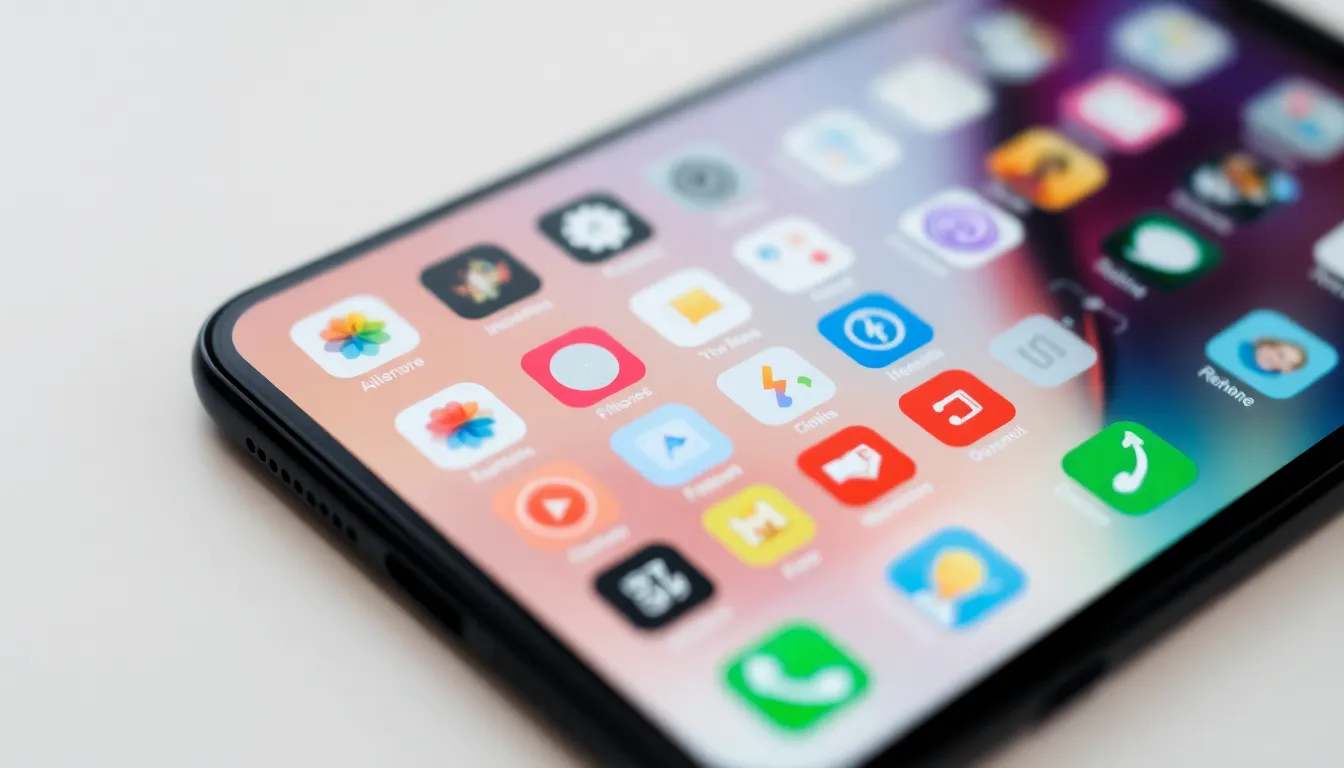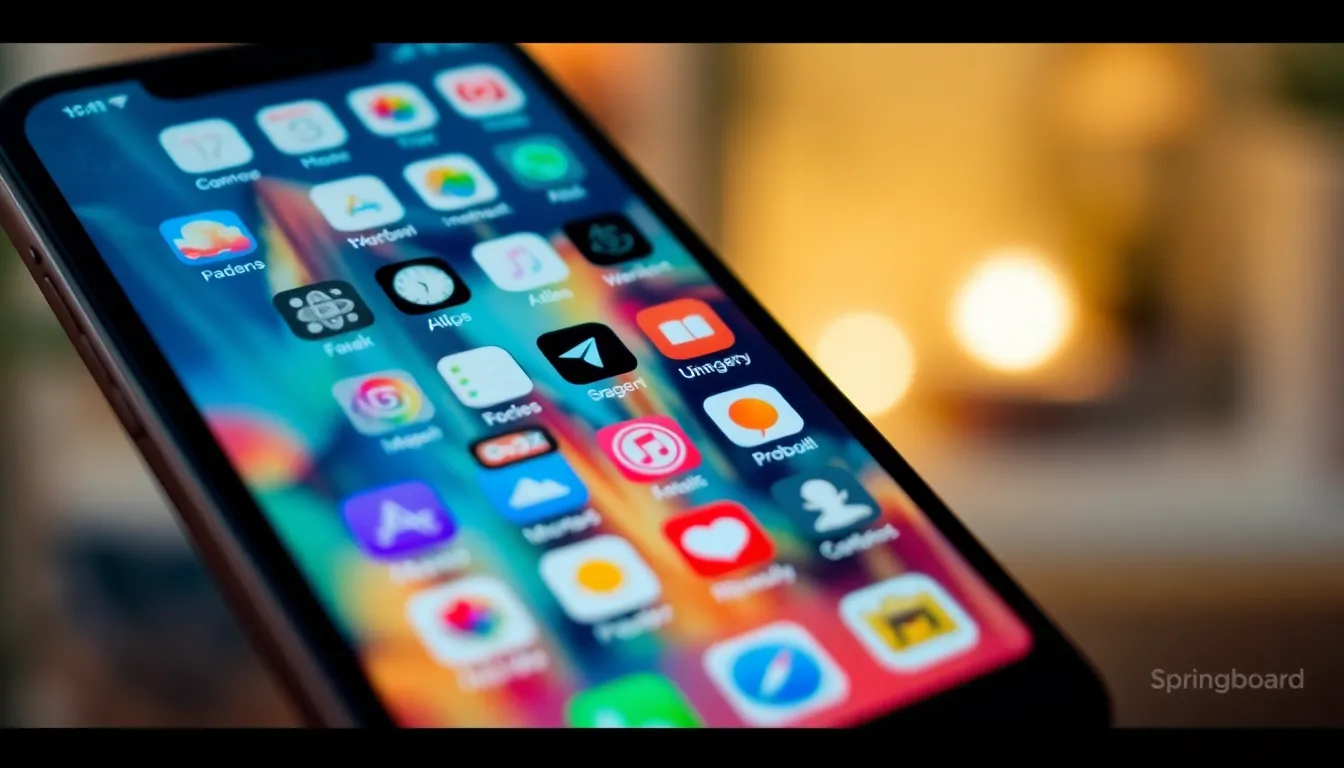Springboard on the iPhone isn’t just a fancy name for a screen; it’s the launchpad for your digital life. Imagine a world where apps leap into action at your command, where your favorite tools are just a swipe away. This is the magic of Springboard, the unsung hero behind every tap and swipe on your iPhone.
Table of Contents
ToggleWhat Is Springboard iPhone
Springboard serves as the main interface for iPhone users, efficiently managing app access. This feature displays home screens filled with app icons and widgets, providing a user-friendly experience. Customization options allow users to rearrange icons, group apps into folders, and add widgets to personalize their devices.
Through Springboard, users can quickly launch applications, facilitating seamless navigation across various tasks. The ability to swipe between multiple home screens enhances accessibility, catering to diverse user needs. Notifications also appear on the Springboard, ensuring users stay informed about updates and messages from apps.
Built-in functionalities like the App Library simplify organization, automatically categorizing apps for quicker retrieval. This feature contributes to a decluttered home screen, making it easier to locate desired applications. Additionally, Springboard supports background app updates, ensuring users access the latest versions without interruption.
Interactivity with the Springboard extends to multitasking capabilities. Users can switch between apps with ease, using gestures or the app switcher. This fluid interaction optimizes productivity, aligning with users’ on-the-go lifestyles.
Springboard also integrates with Siri, Apple’s virtual assistant, further enhancing functionality. Voice commands facilitate hands-free access, allowing users to open apps or set reminders without touching the device. This convenience exemplifies how Springboard plays a pivotal role in elevating the overall user experience on the iPhone.
Core Functions of Springboard

Springboard serves as the operational backbone of the iPhone interface, allowing users to navigate their devices efficiently. Its main functions include home screen management and the app launching process.
Home Screen Management
Home screen management encompasses organizing app icons and widgets for optimal accessibility. Users can drag and drop icons, arranging them to suit personal preferences. Grouping apps into folders simplifies navigation and keeps the home screen clutter-free. Additionally, widgets provide at-a-glance information, enhancing functionality while maintaining visual appeal. The App Library automatically categorizes apps, streamlining retrieval and improving organization on the device. Thus, Springboard enables a personalized mobile experience tailored to individual needs.
App Launching Process
The app launching process in Springboard allows for quick access to applications. Users simply tap an app icon for immediate use, reducing the time spent searching for apps. Swiping between multiple home screens facilitates smooth transitions and easy navigation. Through background app updates, the latest versions of applications are readily available without interference. Furthermore, integration with Siri adds a layer of convenience, allowing hands-free launches and reminders. In this way, Springboard enhances user efficiency and overall app interaction.
User Interface Features
Springboard offers several user interface features that enhance the iPhone experience. Its functionality stands out through customization options and multitasking capabilities, which allow users to tailor their devices to their preferences.
Customization Options
Customization options empower users to personalize their Springboard experience. Users can rearrange app icons on their home screens, enabling a layout that suits their workflow. Grouping apps into folders organizes related applications, making access simpler. Widgets provide immediate information updates and create a visually appealing interface. Additionally, users can remove or hide apps, achieving a clean and decluttered home screen. Overall, these features ensure that each user’s device reflects their unique style and needs.
Multitasking Capabilities
Multitasking capabilities enhance efficiency on the iPhone. Users can quickly swipe between apps, allowing seamless transitions without losing progress. Springboard also supports background app updates, ensuring the latest versions are available when users reopen applications. This minimizes interruption and aids productivity. Users can take advantage of the Split View and Slide Over functions on compatible devices, further improving access to multiple applications. These multitasking features streamline the user experience, making it easier to manage tasks and applications.
Springboard and iOS Integration
Springboard integrates seamlessly with various iOS components, enhancing the overall user experience. This feature acts as a bridge between apps and system functionalities, promoting efficient interactions. Home screen organization relies on built-in tools such as the App Library. Notifications leverage Springboard to provide real-time updates, ensuring users stay informed. Siri interacts with Springboard for voice commands, allowing convenient access to applications. Widgets, embedded within Springboard, supply at-a-glance information for quick reference. Interactions with the Control Center also occur through Springboard, simplifying settings adjustments.
Springboard plays a crucial role in system performance, optimizing resource management. App background updates, facilitated by this feature, ensure users access the latest versions without interruptions. It manages the allocation of system resources, enhancing overall device speed and responsiveness. Multitasking capabilities provided by Springboard significantly improve user efficiency and experience. Transitioning between apps occurs fluidly, minimizing lag and enhancing workflow. Limitations on animation and transitions are managed through Springboard, contributing to smoother operation. Overall, these functions affirm Springboard’s importance in maintaining iOS performance.
Common Issues and Troubleshooting
Springboard users may encounter several issues affecting their experience. Lagging performance often arises when many apps run simultaneously. Closing unused applications can help alleviate this problem.
Apps might not launch as expected, which causes frustration. Restarting the iPhone generally resolves this issue by refreshing background processes. Users should also ensure app updates are installed to prevent compatibility problems.
Customization options may occasionally lose settings. If icons or widgets revert to their previous layout, restoring defaults usually helps. Restructuring the home screen can reintroduce the desired organization.
Notifications sometimes fail to appear on the Springboard. Users should check notification settings for individual apps to ensure they’re enabled. Reviewing iOS settings allows for adjustments in case of missed alerts.
Background app updates can pose challenges when not functioning properly. Users might find certain apps lagging due to outdated versions. Enabling background app refresh in settings ensures applications stay updated without direct user intervention.
Integration with Siri may present issues as well. When Siri doesn’t respond to commands related to Springboard, verifying Siri’s settings is crucial. Making sure the feature is enabled can enhance access to apps through voice command.
Resource allocation could become a concern if the iPhone runs out of storage space. Managing app installations and deleting unnecessary files helps maintain optimal performance. Regularly checking storage through settings prevents slowdowns related to inadequate space.
These solutions address common hindrances users face while utilizing Springboard on the iPhone. Implementing these troubleshooting steps leads to a smoother and more efficient user experience.
Springboard on the iPhone is more than just a home screen; it’s the backbone of a seamless user experience. By providing easy access to apps and tools it enhances both functionality and convenience. The ability to customize layouts and manage notifications keeps users informed and organized.
With features like multitasking capabilities and Siri integration Springboard optimizes productivity and ensures smooth transitions between tasks. Troubleshooting tips further empower users to maintain their device’s performance. Overall Springboard plays a vital role in shaping how users interact with their iPhones making it an essential feature for anyone looking to maximize their digital experience.





